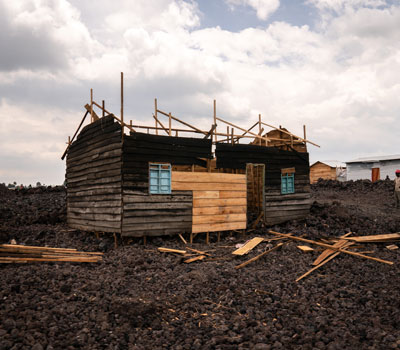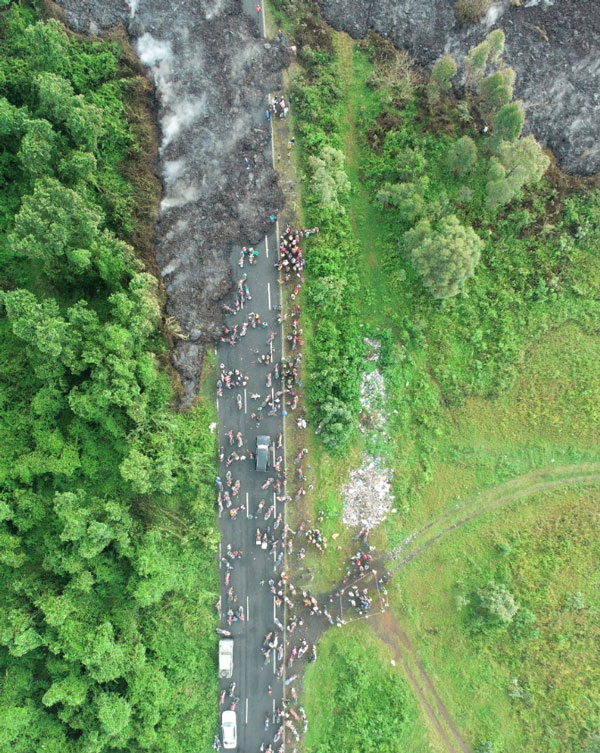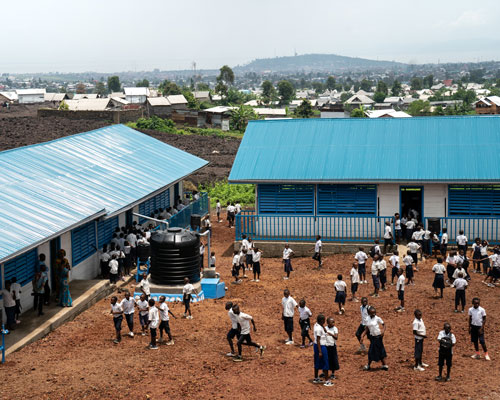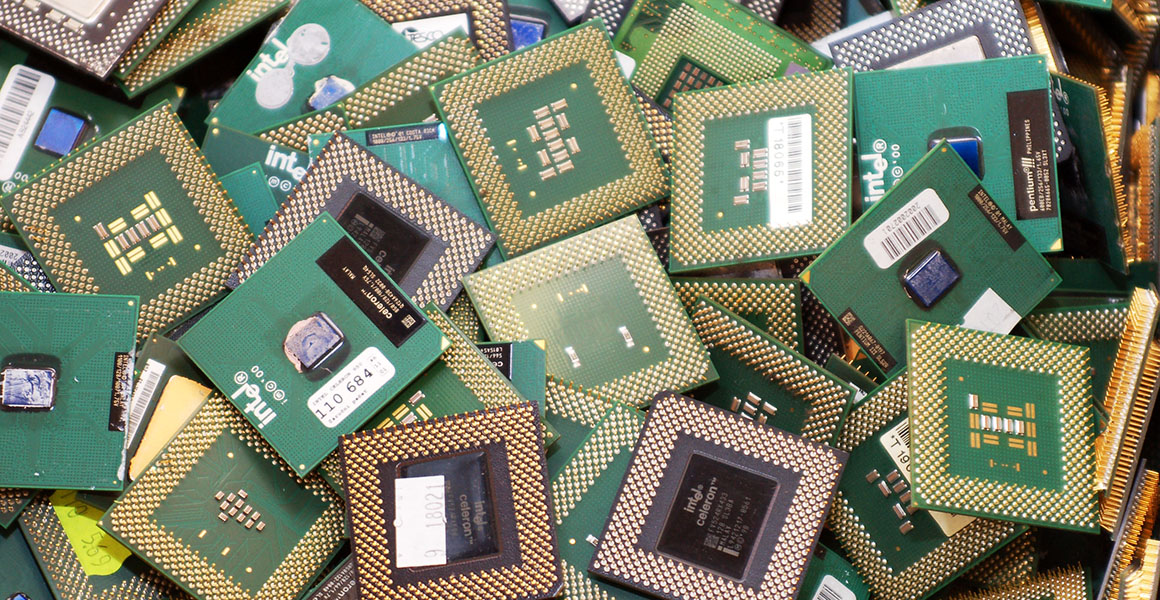
Mount Nyiragongo contains the world's largest continuously active lava lake in its crater. The slightly elliptical lake expands around 230m (east to west) and has been active since at least 1971. Image courtesy of Pierre-Yves Burgi.
undefinedOutrunning the world's fastest-flowing lava and rebuilding Goma one year later
Tammana Begum
First published 22 May 2022
A year after the deadly lava leak of Mount Nyiragongo - Africa's second most active volcano - the people of Goma try and rebuild their lives.
Goma, the capital city of the North Kivu region in the Democratic Republic of the Congo, is a thriving metropolis that is home to around two million people.
But lying just 15 kilometres to the north is Mount Nyiragongo, an active volcano with the fastest-flowing lava in the world.

The suburbs were affected the worst and most of the houses burned easily as they were made of wood © Diana Zeyneb Alhindawi/UNICEF
On 22 May 2021, Mount Nyiragongo spouted lava from cracks along its sides. More than 400,000 people were forced to flee their homes, at least 32 people died and thousands of children were separated from their parents.
Chaka Clarke, co-founder of British grassroots charity I Heart Africa says, 'A lot of the people who lived in the suburbs were farmers - they lost their homes and only source of income in one night.'
One of the reasons why the volcanic eruption was devastating was due to the properties of the lava itself.
Chiara Maria Petrone, a petrologist at the Museum who studies rocks and the processes that form and transform them, says, 'What's unique about Mount Nyiragongo is the composition of the lava, which allows it to travel at an unusually fast speed.
'Silica is a compound which makes lava sticky and therefore reduces the speed of its flow. In the case of Mount Nyiragongo, there is very little of this element. There aren't many places in the world with such fluid lava like that.'
The eruption was followed by several earthquakes that destroyed buildings, cracked pavements, and damaged underground water pipes and an important water reservoir.
The government set up large camps several miles away from the city and worked with various national and international organisations to help mitigate the disaster.

A burnt trail of destruction flows down from Mount Nyiragongo towards Goma © I Heart Africa
However, the location of the camps was not ideal as they were built far from any safe drinking water sources.
Easy access to clean water is vital in situations where a large number of people have been displaced. It helps prevent many serious issues, including diseases such as cholera which can lead to death, particularly in children.
Fast forward a year and the situation has remained more or less the same.
Some families were able to flee their homes with handfuls of money and possessions, giving them hope that they would be able to restart their lives soon. However, this hope has now dwindled to nothing.
'The government has tried to help but in an unsustainable fashion,' explains Chaka. 'It set up six large temporary camps but a lot of the tents have rotted away as it rains frequently in the region. Most people are now living in makeshift shelters using sticks, stones and any plastic sheets they can find.

A boy stands amidst the burnt landscape in the aftermath of the 2021 volcanic eruption © Moses Sawasawa

Lava destroyed most of the suburbs and stopped short of the city limits © Parc National Des Virunga
'Some families have been given small amounts of money to relocate but then left to their own devices. A lot of other organisations offered immediate help too but nothing beyond that.
'There's no mass plan to rehouse these people and give them the dignity that they deserve. What they need is long-term support that allows them to rebuild their lives sustainably.'

Scientists and staff from the Goma Volcano Observatory visited Mount Nyiragongo's crater in 2014 and set up monitoring equipment © Mark Robinson
Exploring a sustainable future for Goma
Since 2021, I Heart Africa has been working to raise money to provide housing, food and security for those displaced by the volcanic eruption.
The charity has so far built four houses, which have been offered to families who want to farm in a sustainable manner. This includes growing high-value crops such as chia seeds, sesame, aloe vera and coffee which can then be exported internationally.
Further donations will help build an additional 20 houses, as well as a school and an orphanage.
Although Mount Nyiragongo has brought destruction to Goma, there are many benefits to living next to a volcano that can help lift the city out of poverty.
'The soil on volcanic land is rich and fertile and great for farming,' says Chiara.
As magma rises to the surface, it brings with it a lot of rich minerals and nutrients from deep within the Earth, including elements such as magnesium and potassium. Once the magma cools down and weathers, it releases the minerals and nutrients into the soil, making it extra fertile.
Fruits and vegetables grown on volcanic soil are known to grow bigger and taste better. Thin layers of ash from recent eruptions can also increase crop yields the following year.
Another huge benefit of living near volcanoes includes geothermal energy - a renewable resource where the heat that rises from within the Earth is used to power cities.
In Iceland, around 85% of the houses are heated this way.
Why is Mount Nyiragongo so active?
Volcanoes often form at the edge of tectonic plates as plates either collide or one submerges beneath another. Some volcanoes form as a result of mantle plumes, where magma rises to the surface from deep in the Earth and is much hotter than the mantle rocks around it. These two formations rarely occur near each other.
Mount Nyiragongo is formed as a result of the East African Rift - the slow tearing of the African tectonic plate which started 22-25 million years ago - as well as a large mantle plume that lies beneath it.

A family sit on the porch of their new house designed and built by local businesses, courtesy of I Heart Africa. The charity is working with the local government and has established a relationship with the army for potential future protection. © I Heart Africa.
'It's hard to say which came first - the rifting and the volcanism are part of the same process,' says Chiara.
Mount Nyiragongo experiences a lot of volcanic and seismic activity beneath it due to the rift, which remains active, and the large mantle plume. As the rift widens, it creates new space for the magma to flow into, whilst the heat from the plume weakens the crust, leading to frequent volcanic eruptions.
The disastrous volcanic eruption of 2002

The eruption destroyed six schools, leaving 20,000 students without access to education. UNICEF installed several school tents and restarted educational activities as soon as possible. The charity later rebuilt 30 classrooms. © Diana Zeyneb Alhindawi/UNICEF.
The last time Mount Nyiragongo erupted prior to 2021 was in 2002 and the effects were catastrophic.
Although the country's mitigation system, the Goma Volcano Observatory, put out a warning days before the eruption, it went unheard as the country was going through political turmoil at the time.
More than 140 people died, mostly from carbon dioxide suffocation, while hundreds of thousands of people lost their homes and fled to neighbouring Rwanda. Two out of four of the city’s hospitals collapsed due to subsequent earthquakes and half of the airport was covered in lava.
Many scientific papers were published as a result, with some warning against rebuilding the city in the same location.
But the Democratic Republic of the Congo is infamous for its production of precious metals and gemstones, and many of the people from Goma are employed as miners. Goma also serves as an important trade route for neighbouring countries such as Rwanda and Uganda, and other countries, such as China.
Any warnings against rebuilding the city in the same location were ignored and the city quadrupled in size following the 2002 eruption.
Adapting to life at the edge of an active volcano
Goma was not always a conflicted city. People have lived there amiably for thousands of years - when access to their own resources allowed them to relocate temporarily if Mount Nyiragongo showed signs of erupting.
However, over the last few centuries, Goma has been heavily exploited. Near the end of the nineteenth century, Goma was subjected to the brutal 23-year-reign of Belgian King Leopold II. The king made a fortune through the collection of ivory and the cultivation of wild rubber by using the locals as forced labour under the threat of mutilation and murder.
'Goma has been repeatedly exploited throughout history and as a result, poverty has increased and the people no longer have the means to move around,' says Chaka. 'The only time they do relocate is when they are forced to, which is when the volcano erupts or if there is a serious conflict. It's a reaction as opposed to a progressive move.'

The southern edge of the city of Goma meets Lake Kivu - a large, deep lake containing dissolved gasses, including carbon dioxide and methane. If the gasses are released, nearby life could die from asphyxiation - a disaster known as limnic eruption. Image courtesy of MONUSCO/wiki (CC BY-SA 2.0).

Mount Nyiragongo lies in Virunga National Park in the Congo Basin - the second-largest tropical rainforest in the world. The area is home to a high number of endemic and endangered species, including forest elephants, bonobos and mountain gorillas. © I Heart Africa.
The people of Goma have invested a lot of time, money and energy into reconstructing the city after past volcanic eruptions. This includes paving roads, building houses and offices, establishing a university with an exchange student programme, and more recently, an art gallery featuring local wood carving, painting and puppets. Leaving their livelihood behind and moving elsewhere would take a huge emotional toll.
'A lot of the time, people who live in areas prone to natural disasters don't want to leave because it is their home and they have a strong personal connection with it,' says Chiara. 'It's where their ancestors were born and where their history is. It's difficult for them to consider moving and establishing their life elsewhere, regardless of whether they are rich or poor.'
In cases where people cannot or do not want to move, it is essential to put plans in place to mitigate disasters. This includes understanding past volcanic events, being well-equipped to monitor the volcano, good communication between scientists, local authority and citizens, and having the means to relocate people quickly when necessary.
'Volcanic eruptions are a natural phenomenon and it's only considered a disaster when people are involved,' says Chiara. 'However, it is possible for people to live near active volcanoes. There are loads of people around the world who already do that, such as in Italy, San Francisco, Japan and Chile.'

The Democratic Republic of the Congo is one of seventeen megadiverse countries in the world, which means it is rich in biodiversity. The country is home to more than 50% of Africa's forests and plays an important role in maintaining the global carbon cycle. © I Heart Africa.
Forgetting Goma amidst multiple threats in Congo
The Democratic Republic of the Congo has long been a victim of colonialism and conflict, and in some instances, mass displacement, famine and rape have been used as weapons of war.
Today, the violence continues, particularly in the east where millions of people have fled their homes due to a complex combination of ethnic disputes and political instability.
Various parties have been fighting for the country's immense mineral wealth, which between 1998 and 2003 resulted in the death of at least six million people- the largest loss of life since World War II.
While Goma falls outside the hotspot of violence in the Democratic Republic of the Congo, it still gets drawn in. Armed rebels live in the surrounding areas and occasionally come down and wreak havoc on the city and its residents by carrying out looting, human trafficking and murder.
Amongst all the chaos that has rippled around the world over the past few years, it can be easy to forget the struggles Goma has been experiencing.
'We need as much awareness as possible, whether it is through conversations or art or media,' says Chaka. 'We need people to learn about what is happening in Goma and the Democratic Republic of the Congo and make conscious decisions about the products they buy and which parties they support.
'The lives of African animals are documented and represented better than the lives of African people and that needs to change.
'If we're going to tell stories of charismatic mammals in the African jungles, we also need to tell stories of the people such as the locals who have lived with these animals for thousands of years, or the guides who have helped the filmmakers reach and document these creatures.
'And if we still want these animals to be there when our children grow up, then we need to change the way we deal with the Democratic Republic of the Congo because every single country is benefiting from the minerals and other resources found in Africa.'



Don't miss a thing
Receive email updates about our news, science, exhibitions, events, products, services and fundraising activities. We may occasionally include third-party content from our corporate partners and other museums. We will not share your personal details with these third parties. You must be over the age of 13. Privacy notice.
Follow us on social media